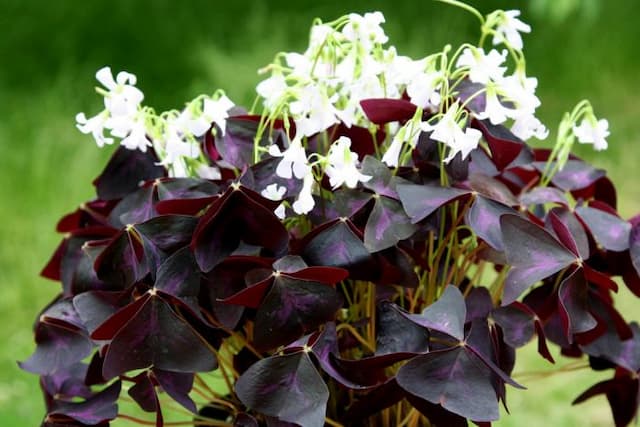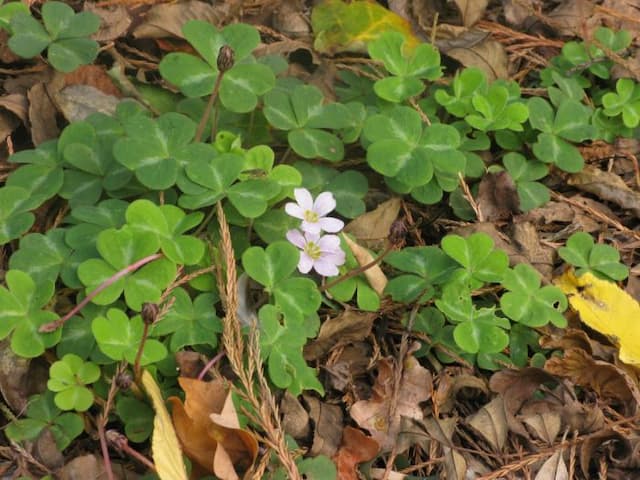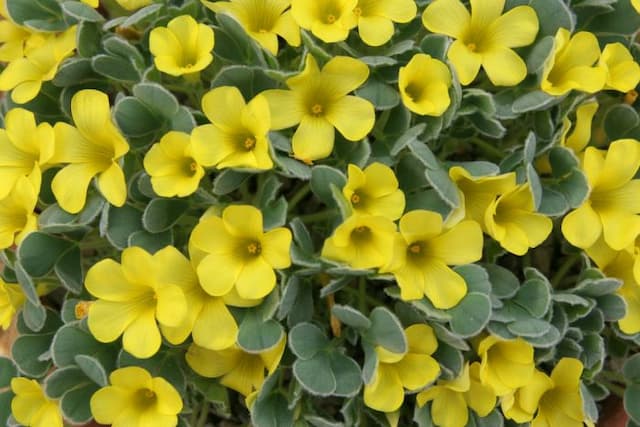Candy Cane Sorrel Oxalis versicolor

ABOUT
Oxalis versicolor, commonly known as the candy cane sorrel, is a visually striking plant well-known for its unique and decorative flowers. The blooms are particularly distinctive with their candy cane-like spirals, featuring alternating bands of white and deep red to crimson, which gives the plant its common name. These flowers are trumpet-shaped when fully open, revealing their contrasting colors even more and giving the plant a festive appearance reminiscent of the holiday season. The foliage of candy cane sorrel consists of clover-like leaves that are trifoliate, meaning each leaf is divided into three rounded leaflets. The leaves are light to medium green in color and can sometimes have a slightly purple hue on the underside, adding to the plant's ornamental value. The leaves are attached to slender stems that arch gracefully, creating an overall delicate and airy look. The plant typically blooms in the spring and summer, revealing its signature flowers that stay tightly coiled when not fully open, almost resembling candy swirls. This coiling protects the pollen and nectar but unfurls on sunny days, inviting pollinators to visit. Although the plant has a bulbous base, it produces its showy flowers and lush foliage giving it an elegant and exotic feel in garden settings or as a potted ornamental indoors. The charming contrast of colors, the spiral shape of its buds, and the attractive greenery make the candy cane sorrel a favorite among garden enthusiasts who are looking to add a touch of whimsy and vivid color to their botanical collection.
About this plant
 Names
NamesFamily
Oxalidaceae
Synonyms
Candy Cane Sorrel, Crinkle-Leaf Plant, Sourgrass, Wood Sorrel
Common names
Oxalis versicolor.
 Toxicity
ToxicityTo humans
The plant known as Candy Cane Sorrel contains oxalic acid and, like other members of the Oxalis family, can be toxic if ingested in large quantities. Consumption of this plant can lead to symptoms such as nausea, vomiting, diarrhea, abdominal pain, and in severe cases, it can lead to kidney stones or kidney failure due to the oxalate content, which binds to calcium in the body.
To pets
Candy Cane Sorrel also poses a risk to pets, particularly cats and dogs, due to its oxalic acid content. If a pet ingests a significant amount of this plant, they may exhibit symptoms similar to those in humans, including vomiting, diarrhea, decreased appetite, or lethargy. In severe cases, consumption can lead to kidney failure. Pet owners should be cautious and prevent their pets from ingesting any part of the plant.
 Characteristics
CharacteristicsLife cycle
Perennials
Foliage type
Deciduous
Color of leaves
Green
Flower color
Mixed
Height
0.5 feet [15 cm]
Spread
0.5 feet [15 cm]
Plant type
Bulb
Hardiness zones
7
Native area
South Africa
Benefits
 General Benefits
General Benefits- Ornamental Appeal: Oxalis versicolor, also known as Candy Cane Sorrel, is valued for its decorative spiraled flowers that add aesthetic interest to gardens and landscapes.
- Low Maintenance: It is relatively easy to care for, requiring minimal attention once established, making it suitable for gardeners of all skill levels.
- Drought-Tolerant: Once established, it can tolerate periods of dryness, which is beneficial in arid regions or for water-wise gardening practices.
- Attracts Pollinators: The flowers of Candy Cane Sorrel can attract beneficial insects like bees, promoting pollination in the garden.
- Compact Growth: With a compact growing habit, it is well-suited for small gardens, borders, or container gardening, allowing for versatility in garden design.
- Seasonal Interest: It provides seasonal interest with its unique blossoming pattern, often in the cooler parts of the season when other plants may not be flowering.
 Medical Properties
Medical PropertiesThis plant is not used for medical purposes.
 Air-purifying Qualities
Air-purifying QualitiesThis plant is not specifically known for air purifying qualities.
 Other Uses
Other Uses- Oxalis versicolor, commonly known as the Candy Cane Sorrel, can be used as a natural pH indicator due to its pigments changing color in response to acidity or alkalinity.
- In educational settings, the plant's quick response to touch can be used to demonstrate nyctinastic movements (movement in response to darkness) to students studying botany.
- The leaves of Candy Cane Sorrel contain oxalic acid and can be used in small quantities to curdle milk for cheese-making experiments.
- Enthusiasts of miniature gardens and fairy gardens employ this plant for its attractive foliage and flowers, adding a whimsical element to their creations.
- Being non-toxic to bees, Oxalis versicolor can be cultivated as a beneficial plant in gardens to attract and support these pollinators.
- Crafters might use the dried flowers of Candy Cane Sorrel for making natural jewelry, such as pendants or earrings, due to their unique shape and coloration.
- Photographers may use the vibrant contrasting colors of the blooms as a natural backdrop for macro photography, enhancing the subject's visual appeal.
- As a natural source of oxalic acid, this plant can sometimes be used in small quantities as a mordant in traditional dyeing processes to fix colors to fabrics.
- The plant's ability to grow in shade and its ornamental appearance make it a suitable addition to terrariums, where it can thrive with minimal maintenance.
- The unique, spiralled buds of Oxalis versicolor can be used by artists and illustrators as subjects for botanical art, providing inspiration with their distinct geometry.
Interesting Facts
 Feng Shui
Feng ShuiThe Candy Cane Sorrel is not used in Feng Shui practice.
 Zodiac Sign Compitability
Zodiac Sign CompitabilityThe Candy Cane Sorrel is not used in astrology practice.
 Plant Symbolism
Plant Symbolism- Joy: The vibrant and unique colors of the Oxalis versicolor, commonly known as Candy Cane Sorrel, bring joy to gardens and spaces, symbolizing happiness and cheerfulness.
- Good Fortune: Many Oxalis species are associated with luck and good fortune, and the striking appearance of the Candy Cane Sorrel reinforces this belief, making it a token of good luck.
- Delightful Surprise: The plant's flowers, which reveal a candy cane-like striping when unfolded, symbolize the pleasant surprises in life due to their unexpected beauty.
- Balance: The Oxalis genus is known for its trifoliate leaves, which resemble a shamrock and symbolize balance and harmony in various cultures.
 Water
WaterThe Candycane sorrel should be watered when the top inch of the soil starts to feel dry to the touch. Typically, this equates to watering approximately once a week, but this can vary depending on the environmental conditions like temperature and humidity. Each watering session should provide enough water to moisten the soil thoroughly, which might be around 16-24 ounces for a standard indoor pot. Be sure to allow excess water to drain away to avoid waterlogging, a condition that this plant is particularly sensitive to.
 Light
LightCandycane sorrel thrives best in bright, indirect light. It can tolerate some direct sunlight, especially in the morning, but it's important to avoid the harsh afternoon sun, which can scorch the leaves. A spot near a north or east-facing window would be ideal, providing the plant with plenty of light without the risk of direct sun damage.
 Temperature
TemperatureCandycane sorrel prefers moderate temperature conditions, thriving at temperatures between 60°F and 75°F. It can withstand short periods of higher temperatures up to about 80°F but should not be exposed to temperatures below 50°F, as it is not cold-tolerant. The ideal range to promote growth and flowering would be maintaining an indoor environment within the preferred temperature bracket.
 Pruning
PruningPruning Candycane sorrel is essential to promote a bushier growth and to remove any spent or withered flowers to encourage new blooms. Pruning should be done in the spring or early summer, when the plant begins to come out of dormancy and you see new growth starting. Depending on the plant's performance, light pruning might be required throughout the growing season to maintain its shape.
 Cleaning
CleaningAs needed
 Soil
SoilCandy Cane Sorrel thrives in a soil mix that drains well and is mildly acidic to neutral, with pH levels ranging from 6.0 to 7.0. A mix of equal parts potting soil, peat, and perlite or sand encourages good drainage.
 Repotting
RepottingCandy Cane Sorrel should be repotted every two to three years or when the pot is visibly crowded. This is usually indicated by bulbs pushing up out of the soil.
 Humidity & Misting
Humidity & MistingCandy Cane Sorrel prefers moderate humidity levels but is quite adaptable; aim for humidity levels of 40-50% for optimal growth.
 Suitable locations
Suitable locationsIndoor
Place Candy Cane Sorrel in bright, indirect light indoors.
Outdoor
Plant in partial shade with well-draining soil outside.
Hardiness zone
7-9 USDA
 Life cycle
Life cycleOxalis versicolor, commonly known as the Candy Cane Sorrel, begins its life cycle as a bulb. Upon encountering suitable growing conditions—typically in spring—it sprouts and grows into a herbaceous plant, bearing distinctive green leaves and spiral, red and white flowers. After pollination, typically by insects, it sets seed which can be dispersed by wind or wildlife, leading to the spread of the plant. As a perennial, Oxalis versicolor dies back to its bulb after flowering and seed set, conserving energy underground during cooler or drier seasons. With the onset of the next favorable growth period, the plant's bulbs will sprout anew, completing its life cycle and beginning the process again. The plant may also propagate vegetatively through bulbils, enabling it to form clumps and spread locally.
 Propogation
PropogationPropogation time
Spring-early summer
Propogation: For the Candy Cane Sorrel, which is known scientifically as Oxalis versicolor, the most popular method of propagation is through division. Ideally, this should be done in the spring when the plant has come out of dormancy and begins to show new growth. To propagate by division, carefully dig up the plant and gently separate the bulbs, ensuring each has a portion of the root system attached. Replant the divisions immediately at the same depth they were originally growing, which is usually about 2 to 3 inches (5 to 7.6 centimeters) deep, and water them well. Division helps to invigorate older plants and is a quick way to create new plants that will be identical to the parent plant and will often flower in their first growing season after division.




